.09 Athlon 64: Value, Speed and Overclocking
by Wesley Fink on October 14, 2004 12:05 AM EST- Posted in
- CPUs
Gaming Performance

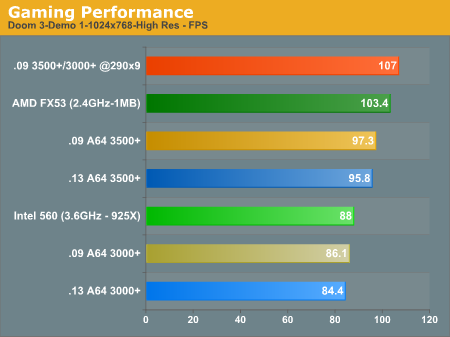
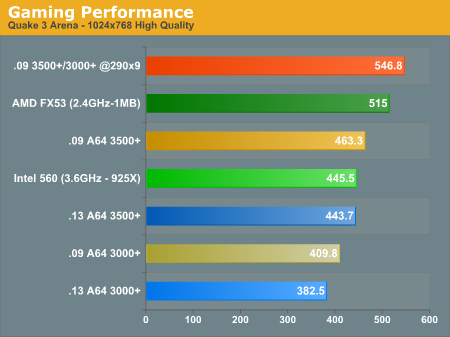
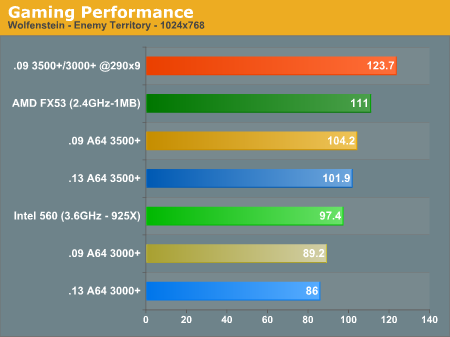
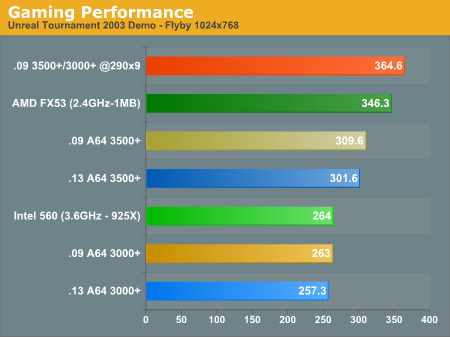
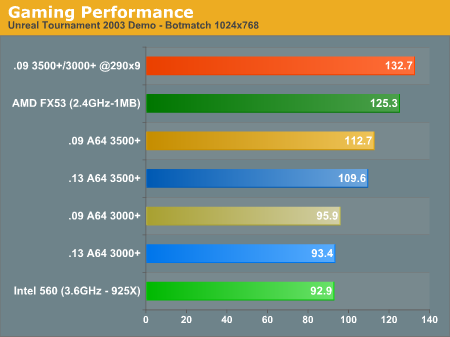
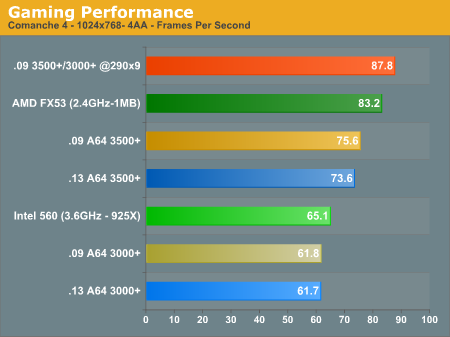
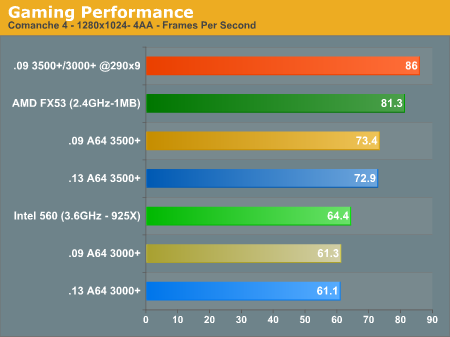
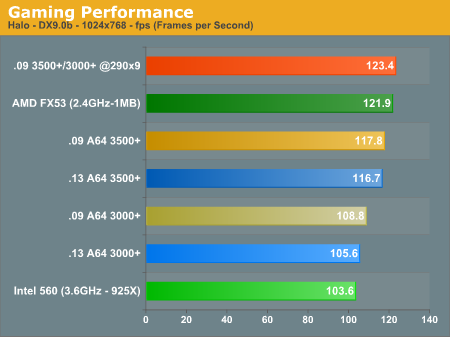
Gaming Performance was consistently faster on the new 90nm than the existing 130nm processors. This varied from 2% in Aquamark3 and Doom3 to 7% in Quake 3. Overall, gaming averaged about 3% faster on the new 90nm chips. While 3% is not a huge increase and it will likely not even be noticed by the average user, it was still impressive to see the new 90nm chips perform a little better than the older 130nm chips.
We have talked in past reviews about how some games respond well to CPU and memory speed increases, while others seem to be most influenced by the graphics card. This is nicely illustrated in comparing benchmarks of the 3000+ at stock speed to the same benches at 2.6GHz (290x9). Here, we see games like Return to Castle Wolfenstein, Unreal Tournament 2003, Quake 3, and Comanche 4 improve 34% to 42% as we move from 1.8Ghz to 2.6Ghz. At the other end of the spectrum, Halo and Aquamark 3 only improve 12% to 13% while the CPU speed increases 45%. Doom 3 falls in the middle with a 24% increase in frame rate for the 45% boost in CPU speed.










89 Comments
View All Comments
slashbinslashbash - Thursday, October 14, 2004 - link
#36 - Athlon 64 processors are unlocked downward, so Wesley was able to go from 11x on the 3500 down to 9x. This downward unlocking allows overclockers to max-out their motherboards and RAM while keeping the CPU running at the same speed. Wesley could have easily achieved the same 2610MHz CPU speed with the 11x multiplier at FSB of 237, but the FSB would have slowed things down.Athlon 64FX processors are unlocked both up and down.
PrinceGaz - Thursday, October 14, 2004 - link
#34- SSE3 support along with other improvements are planned to be added with the E0 revision of the core. The current part is the D0 revision and the only performance improving features are the improved DRAM page closing policy, and second write-combining buffer. They explain why the 90nm parts were slightly faster than equivalent 130nm parts.#35- thanks for pointing out where it says they used a different HSF to the standard retail one. I guess that explains why he was able to put 1.6V in the 3000+ and take it up to 2610MHz without frying it :)
Entropy531 - Thursday, October 14, 2004 - link
#34, look at the CPU-Z screenshot. No SSE3.pio!pio! - Thursday, October 14, 2004 - link
How did you overclock both pieces to 290x9? Dont they have different locked multipliers?fic - Thursday, October 14, 2004 - link
HS used: Thermaltake Silent Boost K8From "Front Side Bus Overclocking Testbed" table in "Overclocking Results and Heat"
IdahoB - Thursday, October 14, 2004 - link
Great article, I'm liking what I see and it's definiately on my hot purchase list.However, I noticed you didn't discuss SSE3 support - I read somewhere else this isn't implemented yet - is that true, and if so when is SSE3 pencilled in for A64s?
tr00p - Thursday, October 14, 2004 - link
I would love for an overclocked SEMPRON 3200+ (939) to be included in this comparison. Initial reviews give this chip high expectations, but I want to see apples-to-apples in a well done review such as this one.SLI - Thursday, October 14, 2004 - link
What about the FX line? Might (have) asked them when they will transition to 90nm? This is important due to the FX having unlocked multipliers (I use Phase-Change and watercooling together so I'm looking to increase multipliers as well as FSB).AlphaFox - Thursday, October 14, 2004 - link
Was the retail HSF used for these overclocks?Also, I dont get why temperatures were not documented... maybe you could list the temps that these CPUs were running under prime95.
Spacecomber - Thursday, October 14, 2004 - link
This information on the overclocking capabilities of the new Atlon 64s is very helpful. The article is much appreciated.It looks like it makes even more important the question of what memories provide the best performance at close to DDR 600 speeds on the Athlon 64 platform. I know this has been addressed looking at the latest PC3200 memories, by Anandtech, but are there other memories with higher speed ratings that might also be considered. For example, what about the Ballistix PC4000; does it pick up where their PC3200 leaves off? Or, is the latest OCZ PC3200 high performance memory that you used the best memory for DDR 600 speeds (or thereabouts) on the NForce3 platform?
Space